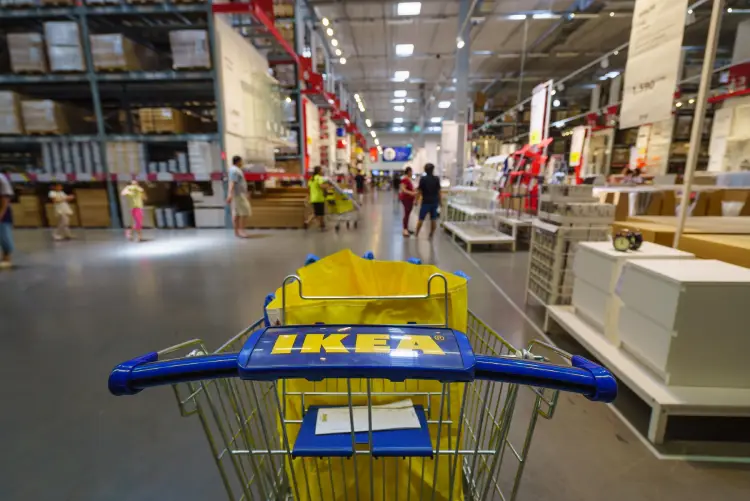
Swedish retail giant Ikea is best known for flat-pack furniture that is easy to assemble straight out of the box. But it has taken a bespoke approach to rebuild its system for customer recommendations, which is already paying dividends.
Ikea, the world’s largest furniture retailer, combined its existing proprietary algorithms for online product recommendations with a new, AI-powered system from Google Cloud. Albert Bertilsson, the company’s head of engineering for edge computing, told Tech Monitor how the resulting insights into customer behaviour have already impacted the company’s bottom line.
Ikea’s CX strategy for the changing customer journey
With more than 420 outlets in 50 countries around the world, the in-store experience remains central for many Ikea customers. But the company’s online presence is also growing in importance, particularly since Covid-19 struck.
“The pandemic has been very complex to deal with, hitting different locations at different times with different policies being put in place,” says Bertilsson. “What we’ve tried to do is meet our customers where they can and want to meet us.”
Even before the pandemic, many customers were using Ikea’s website to plan refurbishments to their homes, Bertilsson says. “Typically our customer relationship crosses the boundary [between physical and digital interactions],” he explains. The digital element, he says, can be anything “from initial research and finding things right through to discovering how things work and customer support”.

Serving up relevant product recommendations is important to increase customer spend. Until recently, Ikea relied solely on a range of self-built systems, Bertilsson says. “We have multiple recommendation systems for different parts of the customer journey,” he says. “These are based on past purchase behaviour, and are good in that they’re very easy to make sense of and maintain.”
But to improve its recommendations, IKEA wanted to be more predictive, explains Bertilsson, “looking at specific personal behaviour and trying to work out what a customer’s biggest interests are”.
Getting to know the customer
As an existing Google Cloud client, Ikea was given early access to Google Recommendations AI, a new tool for delivering predictive recommendations. To train the system, Bertilsson and his team soon realised they needed better data on the company’s customers.
“Where we began this journey we had quite a few models, many of them UX-based in terms of shopping personas,” he says. “These provided some very generalised information for us, but as we dug deeper into it we began to see the large differences were within customers who we thought displayed the same type of behaviour.”
Using existing client data, Bertilsson’s team developed a framework to assess customer patterns, carrying out extensive A/B testing to get more detailed insights into individual shoppers. “Digging into that was a big challenge from a data perspective,” he says. “We were replacing averages with detailed histograms of how customers behaved on their journey.
This was a very humbling experience, in that it opened up new perspectives for personalisation, a more curious and less confined way of thinking. Albert Bertilsson, Ikea
Using this framework, “we were able to find out much more about the customer and get more granular in terms of the information we can use,” Bertilsson says. “This was a very humbling experience, in that it opened up new perspectives for personalisation, a more curious and less confined way of thinking.” He adds: “We learned to trust the data because it might show you things you don’t expect.”
He says the Google tool was a natural fit given the company’s existing relationship with GCP. “It enabled us to introduce the tool with relatively low friction,” he says. “We started with a few use cases and identified places where our existing recommendation algorithms needed improvement or complementary recommendations. We also explored additional ways where more useful information could be presented to the customers through personalised recommendations.”
The AI system features different models such as ‘recommended for you’, ‘frequently bought together’ and ‘others you may like’, which can be paired with different rules and controlled from a central console. Bertilsson says his team were able to experiment with different combinations.
“One of the simplest custom configurations we used was to only recommend items that were in stock, and when items were out of stock we looked at similar items that were available to augment the experience,” he says.
The resulting system combines the best of Ikea’s proprietary algorithms and Google’s AI, and delivers different recommendations at different points in the customer journey. Bertilsson believes this helps the company cover all bases: “Sometimes customers really just want to know what other people are interested in and what the trends are, and want that displayed in a way that’s easy to understand,” he says. “At others we want to be able to guess what they might be looking for next. It’s about finding a balance.”
The fruits of Ikea’s CX strategy
Since the system was introduced earlier this year, Ikea has been reaping the benefits. It has led to what the company describes as “a 400% increase of relevant recommendations” being displayed to users. Bertilsson says this has meant a number of UX changes were needed too, with horizontal scrolling displays being introduced to accommodate the increased range of options. Ikea says it has also seen a 30% increase in the number of click-throughs to recommended products, with the average order value rising 2%.
Bertilsson believes that, for large organisations, a mixture of history-based and predictive algorithms delivers the best customer experience when it comes to recommendations. “If you have the resources, I think there’s a lot to gain from the hybrid approach, where you can evaluate multiple options very precisely,” he says. “The scale of your company dictates the value you get from improving the quality of your recommendations, but for us being a little bit better can make a big difference.”






